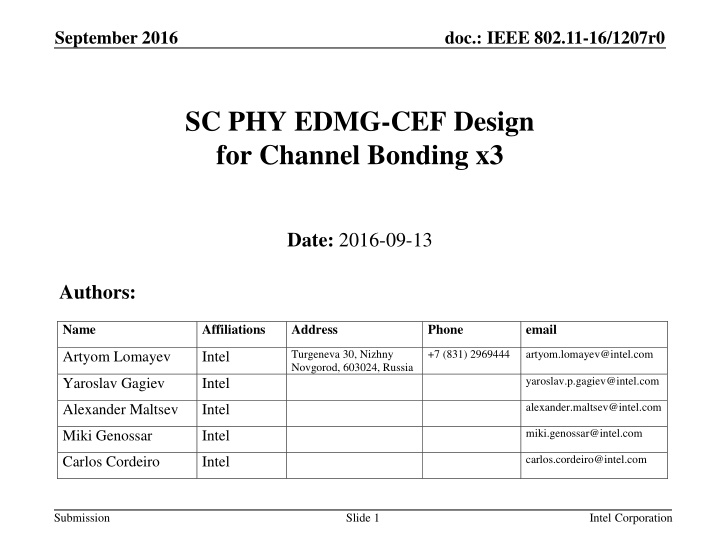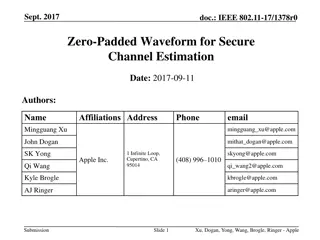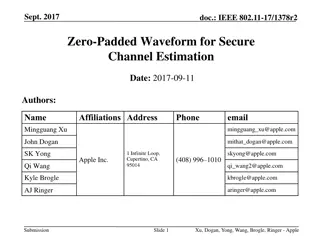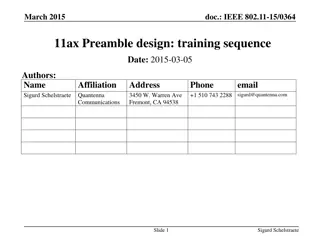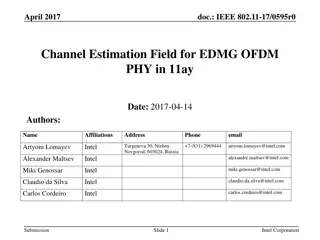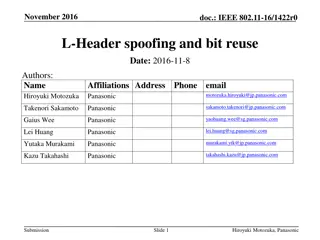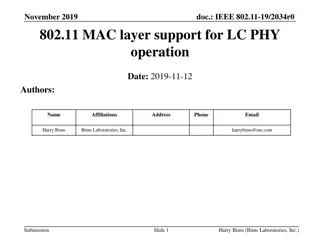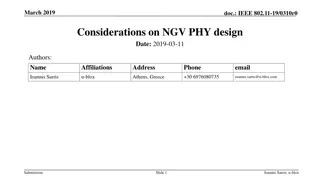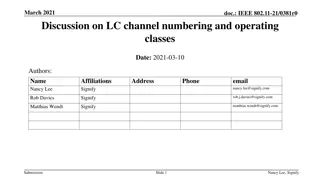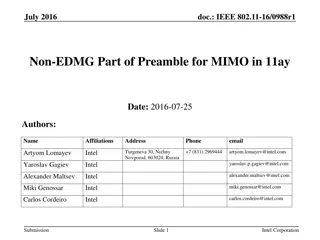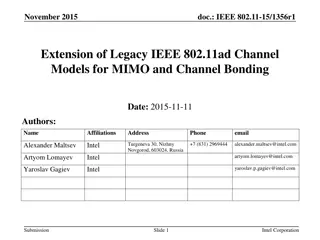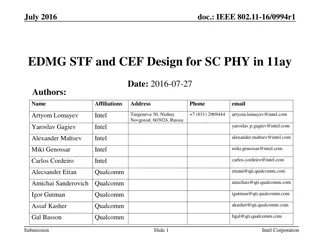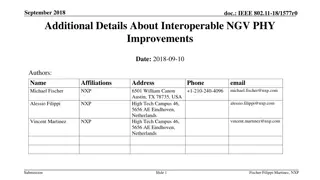Design of Channel Estimation Field for IEEE 802.11-16/1207r0 SC.PHY EDMG-CEF
This presentation discusses the proposed design of the Channel Estimation Field for SC.PHY in the context of channel bonding and covers SISO and MIMO cases. It addresses challenges in defining real value Golay sequences for EDMG-STF/CEF fields and presents a unique solution using quadri-phase complex Golay complementary pairs.
Download Presentation

Please find below an Image/Link to download the presentation.
The content on the website is provided AS IS for your information and personal use only. It may not be sold, licensed, or shared on other websites without obtaining consent from the author.If you encounter any issues during the download, it is possible that the publisher has removed the file from their server.
You are allowed to download the files provided on this website for personal or commercial use, subject to the condition that they are used lawfully. All files are the property of their respective owners.
The content on the website is provided AS IS for your information and personal use only. It may not be sold, licensed, or shared on other websites without obtaining consent from the author.
E N D
Presentation Transcript
September 2016 doc.: IEEE 802.11-16/1207r0 SC PHY EDMG-CEF Design for Channel Bonding x3 Date: 2016-09-13 Authors: Name Affiliations Address Phone email +7 (831) 2969444 Turgeneva 30, Nizhny Novgorod, 603024, Russia artyom.lomayev@intel.com Artyom Lomayev Intel yaroslav.p.gagiev@intel.com Yaroslav Gagiev Intel alexander.maltsev@intel.com Alexander Maltsev Intel miki.genossar@intel.com Miki Genossar Intel carlos.cordeiro@intel.com Carlos Cordeiro Intel Submission Slide 1 Intel Corporation
September 2016 doc.: IEEE 802.11-16/1207r0 Introduction This presentation proposes a design of the Channel Estimation Field (CEF) for SC PHY in case of channel bonding of x3. The proposed design covers SISO and MIMO cases. Submission Slide 2 Intel Corporation
September 2016 doc.: IEEE 802.11-16/1207r0 Problem Statement The presentation [1] defines the real value Golay sequences for EDMG-STF/CEF field in case of SISO and MIMO. The definitions are introduced for the single channel and channel bonding CB = 2 and 4. The supported Golay sequence lengths are equal to 128, 256, and 512. The transmission using channel bonding x3 requires introduction of Golay sequence of length 384. It is well known that bipolar Golay sequences of this length do not exist. Submission Slide 3 Intel Corporation
September 2016 doc.: IEEE 802.11-16/1207r0 Proposed Solution The proposed solution: The proposed solution uses a quadri-phase complex Golay complementary pairs instead of real value bipolar Golay sequences; The Golay complex sequences use in their definition not just { 1} elements, but rather supplement them with { j} elements forming a complex set { 1, j}; The complex Golay complementary pair of length 3 can be defined as follows: Ga3 = [+1, +1, -1]; Gb3 = [+1, +j, +1]; Here the Gb3 sequence uses in their definition +j extra element; Using these basic sequences one can get the sequences of length 384 required for the CEF x3 definition; Submission Slide 4 Intel Corporation
September 2016 doc.: IEEE 802.11-16/1207r0 Proposed Solution (Cont d) Proposed solution (cont d): In order to get a required length of 384 for Ga384 and Gb384 sequences to be used in the CEF definition, one needs to apply the following recursive operation: A0(n) = Ga3(2-n); B0(n) = Gb3(2-n); Ak(n) = Wk*Ak-1(n) + Bk-1(n-Dk); Bk(n) = Wk*Ak-1(n) Bk-1(n-Dk); NOTE: the difference from the standard definition is that A0(n) and B0(n) sequences at the zero iteration are not Dirac delta functions, but rather Ga3(2-n) and Gb3(2-n) introduced at the previous slide, order of samples is inverted; Starting from the length N = 3 and making 7 iterations, one will get 128 * 3 = 384 the required sequence length; The vector Dk is defined as delay vector for N = 128, but all its elements are multiplied by 3, the weight vector Wk is kept unchanged as for N = 128: Dk = [1 8 2 4 16 32 64] * 3; Wk = [-1 -1 -1 -1 +1 -1 -1]; Submission Slide 5 Intel Corporation
September 2016 doc.: IEEE 802.11-16/1207r0 Proposed Solution (Cont d) EDMG-CEF x3 definition: Definition of Ga384 and Gb384 sequences: Ga384(n) = conj(A7(383-n)), Gb384(n) = conj(B7(383-n)); Then the Gu1536 and Gv1536 sequences of the CEF can be defined as follows: Gu1536= [-Gb384, -Ga384, +Gb384, -Ga384]; Gv1536= [-Gb384, +Ga384, -Gb384, -Ga384]; This makes Gu1536 and Gv1536 sequences complementary and solves the issue with channel estimation in frequency domain; NOTE: once per 6 symbols the phase of adjacent samples will experience -radian flip, even after application of exp(j /2*n) rotation, however this does not affect much the PAPR properties of the signal at the output of pulse shaping filter; Submission Slide 6 Intel Corporation
September 2016 doc.: IEEE 802.11-16/1207r0 Proposed Ga384/Gb384 Sequences Sequences: NOTE: j element appears once per 6 symbols, therefore does not affect much PAPR; Submission Slide 7 Intel Corporation
September 2016 doc.: IEEE 802.11-16/1207r0 Golay Generator for x3 Golay generator scheme: Based on the Ga128/Gb128 sequence generator; Multiplies all delays (except of D = 1) by a factor of 3; Requires modification of the first butterfly for delay D = 1 and replace it by D = 5; Total number of delays: Ga128/Gb128: 127 delays = 1 + 8 + 2 + 4 + 16 + 32 + 64; Ga256/Gb256: 255 delays = 1 + 8 + 2 + 4 + 16 + 32 + 64 + 128; Ga384/Gb384: 383 delays = 5 + 24 + 6 + 12 + 48 + 96 + 192; Ga512/Gb512: 511 delays = 1 + 8 + 2 + 4 + 16 + 32 + 64 + 128 + 256; In all cases the number of delays is equal to N-1, where N is a length of the sequence; Next slide shows Golay generator scheme for the sequences Ga384/Gb384; Submission Slide 8 Intel Corporation
September 2016 doc.: IEEE 802.11-16/1207r0 Golay Generator for x3 (Cont d) Golay generator for Ga384/Gb384: Ga384(n)/Gb384(n) are defined as inverted in time and conjugated sequences: Ga384(n) = conj(A7(383-n)), Gb384(n) = conj(B7(383-n)); Z in the picture defines a delay unit; Golay correlator has the same structure; First butterflymodification -W1 W2 W3 Wk . A W1 [n] W1 + + + + B . - - - Z Z Z Z Z D2 D3 Dk - +j Submission Slide 9 Intel Corporation
September 2016 doc.: IEEE 802.11-16/1207r0 PAPR Signal Properties Compared CEF signal definitions: Using Ga256/Gb256: Gu1536= [-Gb256, -Ga256, +Gb256, -Ga256, -Gb256, +Ga256]; Gv1536= [-Gb256, +Ga256, -Gb256, -Ga256, +Gb256, -Ga256]; Using Ga384/Gb384: Gu1536= [-Gb384, -Ga384, +Gb384, -Ga384]; Gv1536= [-Gb384, +Ga384, -Gb384, -Ga384]; PAPR estimation: At the output of pulse shaping filter defined in the 11ad std. at the 2.64 GHz sample rate, [2]; Results: Using Ga256/Gb256: PAPR = 3.11 dB; Using Ga384/Gb384: PAPR = 2.93 dB; Conclusion: Similar properties; Submission Slide 10 Intel Corporation
September 2016 doc.: IEEE 802.11-16/1207r0 Proposed GSS for MIMO Proposed delay vector and weight vector for MIMO GSS: Delay vector is fixed and not dependent on the stream number: Dk = [3, 24, 6, 12, 48, 96, 192]; Weight vector depends on the stream number: Streams 1 and 2: Wk = [-1,-1,-1,-1,+1,-1,-1]; Streams 3 and 4: Wk = [-1,-1,-1,+1,-1,-1,+1]; Streams 5 and 6: Wk = [-1,-1,-1,+1,-1,+1,+1]; Streams 7 and 8: Wk = [-1,-1,-1,+1,+1,+1,-1]; Input definition: Streams 1, 3, 5, 7: (A0(n), B0(n)) = (+Ga3(2-n), +Gb3(2-n)); Streams 2, 4, 6, 8: (A0(n), B0(n)) = (+conj(Gb3(2-n)), -conj(Ga3(2-n))) ZCC sequences; To obtain the ZCC sequences for the streams 2, 4, 6, and 8 simple modification of the first butterfly is required: switch between A and B, complex conjugation and sign inversion; Output definition: Streams 1 - 8: (Ga384(n), Gb384(n)) = (+conj(A7(383-n)), +conj(B7(383-n))); Submission Slide 11 Intel Corporation
September 2016 doc.: IEEE 802.11-16/1207r0 Golay Set Properties Analysis N = 384 Figure below shows MF output for 8 sequences in the set, for Ga and Gb separately. It is shown that all sequences in the set have very similar autocorrelation properties (except of side lobes). Shaping filter is used as defined in the 11ad std., [2]. Graphs are shown after application of Matlab FFT shift function. Gb sequences Ga sequences Submission Slide 12 Intel Corporation
September 2016 doc.: IEEE 802.11-16/1207r0 Conclusions This presentation proposes EDMG-CEF field design for SC PHY in case of three channels bonding for SISO and MIMO transmission. Submission Slide 13 Intel Corporation
September 2016 doc.: IEEE 802.11-16/1207r0 Straw Poll Do you agree to insert the following into the SFD: 11ay specification shall define the Golay sequences of length 384 for EDMG-CEF to support CB=3 defined in 11-16-1207-00-00ay on slides 5, 6, and 11 using the EDMG-CEF structure defined in the SFD. Submission Slide 14 Intel Corporation
September 2016 doc.: IEEE 802.11-16/1207r0 References 1. 11-16-0994-01-00ay-EDMG-STF-and-CEF-design-for-SC-PHY- in-11ay Draft P802.11REVmc_D5.4 2. Submission Slide 15 Intel Corporation
